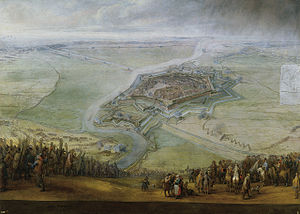Battle of Gravelines (1558)
| Battle of Gravelines | |||||||
|---|---|---|---|---|---|---|---|
| Part of the Italian War of 1551–1559 | |||||||
 The Siege of Gravelines by Pieter Snayers. Oil on canvas. Museo del Prado, Madrid. |
|||||||
|
|||||||
| Belligerents | |||||||
|
|
|
||||||
| Commanders and leaders | |||||||
|
|
|
||||||
| Strength | |||||||
| 12,000 infantry 2,000 cavalry |
15,000 infantry 3,000 cavalry |
||||||
| Casualties and losses | |||||||
| 12,500 dead, wounded, or captured | 300 dead or wounded | ||||||
The Battle of Gravelines was fought on 13 July 1558 at Gravelines, near Calais, France. It occurred during the twelve-year war between France and Spain (1547–1559).
The battle resulted in a victory by the Spanish forces, led by Lamoral, Count of Egmont, over the French, led by Marshal Paul de Thermes. The Spanish were supported by the English Navy, who opened fire on the French as they reached the sand dunes at Gravelines.
Following the dominance of the Spanish forces, led by Duke Emmanuel Philibert of Savoy, at the Battle of San Quentin, Henry II of France prepared his revenge. He recruited a new army in Picardy, which he put in the hands of Louis Gonzaga, Duke of Nevers. He asked the Ottoman Sultan for naval support and encouraged the Scots to invade England from the north. Francis, Duke of Guise, seized the port of Calais from the English and moved to the city of Thionville (on the border between Flanders and France), a city that had been overtaken by the duke's army on 22 June 1558. Marshall de Thermes invaded with another army consisting of 12,000 infantry and 2,000 cavalry, armed with a considerable amount of artillery. After crossing the Aa River at its mouth, de Thermes commandeered his army to conquer both Dunkirk and Nieuwpoort, consequently threatening Brussels. It is reported that a Spanish army was to later intercept the duke's army at the Aa River.
The Duke of Savoy and Philip met an army of 15,000 infantry and 3,000 cavalry, giving the command to the Count of Egmont. Surprised by the speed of the Spanish maneuver, Thermes had to do battle because he had the river behind him, the sea on his left, and his right completely blocked by the baggage column of his own army. He deployed his army on the left bank of the river, creating a double line with the cavalry and artillery in one row and the infantry in a second row behind them.
...
Wikipedia
